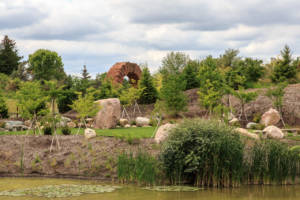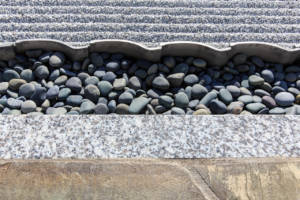
Midwestern Landscape, Japanese Philosophy Take Root in Michigan
Twenty years ago, Frederik Meijer, a Michigan philanthropist who pioneered one-stop shopping (pre-Walmart), and his wife, Lena, provided key financing for 158 acres of public gardens. Today, Grand Rapids’ Frederik Meijer Gardens and Sculpture Park includes a tropical conservatory, themed indoor and outdoor gardens, nature trails and train rides, sculpture galleries, and learning centers. Last summer gates opened to the Richard and Helen DeVos Japanese Garden.
On a recent pilgrimage to the gardens, lead horticulturist Greg Afman led the way through the Japanese-inspired space and methodology.
GC: Meijer Gardens already encompasses gardens, meadows, woodlands, and wetlands. What prompted a Japanese addition?
GA: Over a decade ago, they were thinking of creating a ‘gardens around the world.’ The area was designated for English or French gardens, but Fred (Meijer) bumped into David Hooker, the CEO, and said, ‘What do you think about a Japanese garden?’ Lena, his wife, loves taking tea and Japanese gardens.
GC: What is the biggest attraction thus far?
GA: The Zen-Style garden has drawn a lot of people because they are experiencing something new. It’s a popular place for people to explore and figure out.
GC: I overheard several visitors with this question: How do you arrange the pebbles without leaving footprints?
GA: I pull the rake, rather than push it, covering up my footprints. Where I end, I climb a bit and jump off a boulder.
GC: American artist Jenny Holzer is brilliant, but she is not Japanese, and neither is Anish Kapoor. How were sculptural works selected?
GA: Initially, they thought about only including Japanese artists, but then it dawned on them not to worry about where artists were from, but their overall aesthetic. All of these works have a minimalist aesthetic; they play on perspective and blend with the garden.
GC: What are a Japanese garden’s essential elements?
GA: You can have a Japanese garden with stones or boulders only. They set the stage. Then you come in with plant material. Plants can work with and accentuate stones, or they can be used for favor, to cover up space where stones cannot be used.
Other basic design elements include negative space and gaps, room for the viewer’s imagination to enter the site. Asymmetrical balance adds motion and surprise, so that the viewer can’t grasp everything at one go.
GC: Is there much maintenance?
GA: Nurturing plant material plays a huge role. You can’t just plant and walk away. You need to keep right the proportions with boulders, architecture, and human scale.
GC: We passed a Japanese teahouse. When are the tea ceremonies?
GA: Sometimes the tea house is open for visitors to see utensils and ceramics. They can reserve (online) a shortened version of a ceremony (60-90 minutes) with tea or matcha and Japanese sweets.
GC: You mentioned a pruning technique for young trees.
GA: Yes, pruning is for proportion, interest, and to create a mature tree. With a young tree, all branches point up to sky; older ones angle down to the grown. When pruning, we remove anything that points straight up or straight down, and save anything that is coming straight out from trunk. This creates negative space.
GC: So the goal in a Japanese garden is to promote aging and disguise youth!
GA: If you go to a nursery, the average person can’t afford to buy the tree you have in mind; also, mature trees are hard to move. The idea in Japanese pruning is to get to the image in your mind as fast as possible.
GC: Who devised the color scheme?
GA: Garden designer Hoichi Kuriso selected the plants. He wanted a muted pallet. Japanese gardens are not meant to shout at you, they are more of a whisper. It’s more about textures.
“If you go to a nursery, the average person can’t afford to buy the tree you have in mind; also, mature trees are hard to move. The idea in Japanese pruning is to get to the image in your mind as fast possible.”
GC: Do you have a favorite source of texture?
GA: Moss is always a great staple. It is soothing to the eye. Japanese like it because it has patina and beauty in imperfection. You can’t buy moss growing over stone. It transcends the human touch.
GC: Is there anything you miss from your time in Japan that has been tough to implement here?
GA: In Japan, you’re surrounded by 300 year-old gardens and you get used to that age. I knew the elements, but it didn’t really hit me until here how bright a new garden is. Shadow plays a huge role, and the balance of light. In Japan, you can go to a garden in the middle of the day and find these intense, dark, shadow spots. But here, we don’t have that yet. I’m excited to watch the yin and yang, shadows and light, balance out.






































